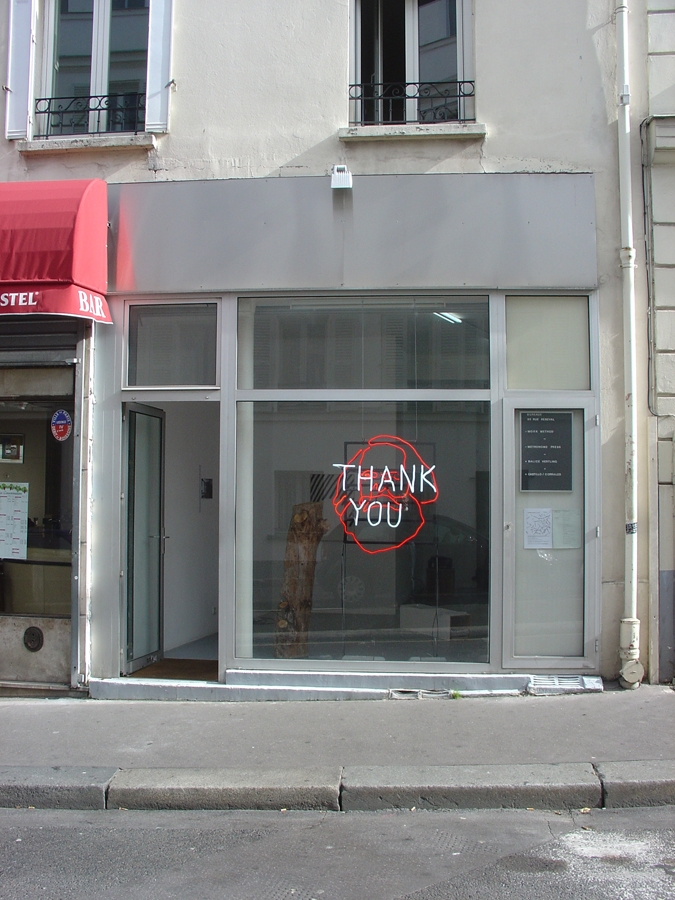The first time I had a meeting at Castillo/Corrales it was a busy Saturday in the Belleville gallery and the artist David Douard was looking after the space, fielding questions about the exhibition and manning Section 7, the in-house bookshop. “Just go upstairs and make yourself at home,” Douard said. “Do some work, use the computer, make coffee, whatever… Just make yourself at home.” So I did. I made my way up the narrow stairs to the flat (which houses visiting artists, curators and suchlike), did a bit of washing up, made a pot of coffee, logged out of the Castillo/Corrales Gmail on the Mac in the office and into my own account. Time wore on, and stirring noises came from the room across the hall.
Liam Gillick, half asleep, grizzly round the chops, lurched out of the bedroom. “Oh, hi,” I said (we don’t really know one another). “Would you like some coffee?” He assented, gruffly, and I washed another mug. Soon the Italian artist Alex Cecchetti appeared, apparently there to fix the windows. Another mug, another coffee, a conversation about the window frames. And there it was: “Make yourself at home.” A welcoming, immediate intimacy that I have never experienced at another organisation, but have since come to appreciate as integral to this one.
Liam Gillick, half asleep, grizzly round the chops, lurched out of the bedroom. “Oh, hi,” I said (we don’t really know one another). “Would you like some coffee?”
Exhibitions at Castillo/Corrales (which takes its name from a historic boxing match) often have the enjoyable riskiness and intellectual glee that come with artist-curated shows – 2010’s Breaking Point: Katherine Bigelow’s Life in Art comes to mind. ‘Let’s keep it simple’ read the press release: ‘In the 1970s in New York, Kathryn Bigelow was part of the art world. She collaborated with Lawrence Weiner, Art & Language, Vito Acconci, Richard Serra, and others.’ By presenting Bigelow’s early conceptual collaborations, the exhibition asked how these might have influenced the career of the first woman to win an Academy Award for Best Director.
The Issues of Our Time, a 2013 exhibition of four female artists – Bonny Poon, Loretta Fahrenholz, Morag Keil and M.lanie Matranga – took a quote from Victoria’s Secret model Rosie Huntington-Whiteley, about creating a brand of the self, as the departure point for a question that many artists face in their own careers. CCA Wattis director Anthony Huberman has regularly returned to curate the ‘Castillo/Corrales biennial’. A pamphlet edition of Donald Barthelme’s 1969 short story ‘Paraguay’ (which describes a journey into an invented country of unfathomable laws) has been reissued as the calling card for the gallery’s publishing house, Paraguay Press, which has published artist books with Dora Garc.a and Lili Reynaud-Dewar.
Founded in 2007 by five artists – Thomas Boutoux, Boris Gobille, François Piron, Benjamin Thorel and Oscar Tuazon – in a tiny space on Rue Rébeval, Castillo/Corrales started with undefined ambitions and purposes – storage/office/shared studio/occasional gallery – though the amorphous status of the collective was shaped by its constantly changing space; Tuazon – known for his rough, architectural sculptures and installations – was constantly modifying the architecture, using it as a playground or test-bed for his own work.
Though it still runs on favours, fundraising and the energy of the group, Castillo/Corrales has moved to a slightly bigger space close to commercial galleries in Belleville, and the collective has changed and swollen to include (around) 11 members, each with varying roles. (The ‘us’ section of the website commences: ‘Admittedly, this is where it can get a little confusing sometimes’.) They pleasingly describe themselves as a ‘headless’ organisation; as Boutoux puts it, this lack of fixity allows them to ‘keep the range of ways of working in the artworld open, and somehow resist and criticise the naturalisation of ways of working as necessarily, ineluctably, individual, career-driven, obsessed by visibility, top-down, authoritative, humourless, unfriendly, macho.’
While such attitude might gladden the heart anywhere, in Paris, where artist-run organizations are few, it seems more like lifeblood. And surprisingly effective. Because somehow, even in an organisation with no head and many arms, the Gmail account gets answered, the shows go on, books get published, the windows get fixed and the coffee gets made.
This article was first published in the April 2014 issue.
